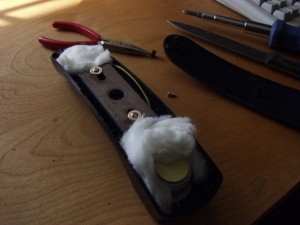I have been grieving ever since Voicepulse canceled its flexrate program and been looking for a new low-price provider with good quality.
Continue reading Flowroute
Category: telephony
Reducing Echo in Telephone Handsets
A common source of echo in VoIP phone systems is the telephone handsets. Of course, non-VoIP phone systems have this source of echo too, but it often is not so evident because without the buffering the echo delay is not as long.
Old Bell 500 series telephones have a wad of cotton wool in the handset to prevent sound from traveling from the receiver, through the hollow handset body, to the transmitter. But, many modern telephone handsets lack this important component. Here I show how I added cotton wool to the handset of a Linksys SPA-841 in order to reduce echo.
Continue reading Reducing Echo in Telephone Handsets
How to be a Good VoIP Provider for Asterisk Users
There is more to being a good VoIP telephony provider for Asterisk users than simply offering the best balance of price and reliability. Usability is also very important. Here are some things which make for a service more convenient for Asterisk users.
Continue reading How to be a Good VoIP Provider for Asterisk Users
Is open source telephony a serious option?
I was recently asked whether anyone would every really consider replacing a tired old PBX with an open source system and whether we had any experience with Asterisk. Here is the answer I wrote, based on our experience here at Trinity College.
Continue reading Is open source telephony a serious option?
Join the DUNDi cloud, call Europe!
Do you have an Asterisk box and an underutilized T1? Or do you have a large number of DID numbers on your PBX? Why not join a DUNDi cloud and trade access to your numbers or to your local calling area for access to other organizations’ numbers and local calling areas?
Continue reading Join the DUNDi cloud, call Europe!
My VoIP network
I run a VoIP network for my friends and family. There are phones at about 10 locations. Four of the locations have Asterisk servers.
Three of the Asterisk servers are run in a redundant configuration. SIP query DNS to get the list of servers for our domain and try connecting to them in the order specified by the domain’s SRV record. It does not matter to which server the SIP phone ultimately connects because the servers are connected by DUNDi. When one of the phones is called, the server which receives the call uses DUNDi to determine with which server the phone is registered and routes the call to that server over IAX2.
These three main Asterisk servers have trunks to the PSTN. They also collect call detail records which they share with one another.
The fourth Asterisk server runs on the same Linksys WL-500G Premium which serves as the gateway router at my parents’ house. It servers the SIP phones in their house. It has a much more limited configuration. It relies on the main servers for connection to the PSTN and does not keep its own call detail records.
In future postings I can describe:
* PSTN providers used
* Least Cost Routing
* Collecting and displaying CDR
* Inexpensive SIP phones used
If you would like to hear about any of these topics, please post a comment.
Inexpensive home Asterisk server
I have a new Asterisk server at home. It is a Contec IPC-BX/M600(PCW). This is a wall-mount PC. It is about a foot square and about two inches thick. There is no power brick. The power cord plugs directly into the box. It has a 400MHz processor which should be fast enough for home or small-office use. It has only 64MBytes of RAM, so you need some swap, particularly when compiling Asterisk.
I bought this marvel new on E-Bay for about $55 including shipping. I added a laptop hard disk for storage.
Power consumption is reasonable, about 15 watts when idle.
Yet another VoIP blog
There is already no shortage of IP telephony blogs. Many of them are valuable and interesting. Many of them are written from the standpoint of a observer watching the facinating new devices and services which appear on the market.
My blog will take a different direction. It will be written from the standpoint of a telephony hobbyist. It will be about my attempts to use Asterisk and surplus equipment to create a telephone system for my family and friends.
I hope to cover such topics as hacking Linksys ATA’s and creating a custom Asterisk dialplan from scratch.
IP telephony has been my hobby for two years now. For a year now it is also part of my work at a small college in New England. So, I may tell about our experience intergrating Asterisk with a Nortel Meridian phone switch.

